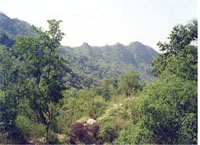
Protected areas to save Yemen’s biodiversity [Archives:2006/940/Health]
April 24 2006
   |
[email protected]
Bilqis gazelle, Yemen warbler, white-eyed gull, sterna and dragon and cucumber trees are names of species that existed plentifully in Yemeni nature, but nowadays, these species are extinct or threatened with extinction. These species are among many plant and animal species that are disappearing from the earth at an alarming rate.
According to biologists, life on earth now faces the most severe extinction period since the event that drove dinosaurs to extinction 65 million years ago. Species of plants, animals, fungi and microscopic organisms daily are exposed to extinction. In fact, biologists estimate that three species become extinct every hour and many scientists believe that human activity largely is responsible.
Therefore, biodiversity – biological variety that thrives in a healthy ecosystem – became the focus of intense international concern during the 1990s.
Biodiversity in Yemen
There is no strict data or study naming the rare and unique species in Yemen, but many researchers believe that Yemen enjoys biodiversity due to its distinguished geographic location. For example, Socotra Island contains 850 plant species, 254 of which cannot be recognized in other world regions.
Yemen registered 71 wild mammal species, a third of which rarely are found in Arab countries. There are also 363 bird species representing 18 classes and 61 families. Some of these birds are threatened with extinction internationally, but they can be found in Yemen, such as the greater spotted eagle, the imperial eagle, the comerake, the ferruginous duck and the white-eyed gull.
However, population expansion, deforestation, cutting and burning of trees, random hunting and pollution are some reasons creating disorder in these species' ecosystems, leading the government to respond to such alarms by cooperating with various organizations, programs and techniques intended not just to keep individual species from becoming extinct, but to defend unique ecosystems.
In this regard, Yemen's Environmental Protection Authority (EPA) developed a National Biodiversity Strategy and Action Plan (NBSAP). Finalized in 2004, the plan represents a major step toward a national program aiming to conserve and wisely utilize Yemen's limited but yet unique natural resources.
Protected areas
The EPA cooperated with international organizations like the World Conservation Union (IUCN) to launch the May 2005 Collaborative Management of Protected Areas and Natural Resources project. Funded by Italy's Directorate General for Development Cooperation, the project aims to support implementing the NBSAP, developed with IUCN input.
Under the project, the IUCN will work with its Yemeni partners, focusing on developing an effectively managed nationally protected area network, improving community participation and gender equity and strengthening Yemeni collaboration with its regional and international partners in the biodiversity field.
“The authority is ready to cooperate with environmental organizations and experts to define the problems, needs and priorities for protected areas,” EPA chief Mahmoud Shdeiwa said.
He noted that the EPA is working to establish and declare many land and marine protected areas. “The EPA is studying management plans for protected areas such as Sharma and Jathmun in Hadramout governorate, Bir Ali in Shabwa governorate, Al-Habari in Al-Mahra governorate and bird and wetland protected areas in Aden governorate,” Shdeiwa said.
He added that the EPA also is studying desert regions where gazelles live in order to declare these regions. However, so far, Yemen has declared only four protected areas: Bora, Hawf, Otma and Socotra.
Challenges and difficulties
Seventy-five percent of Yemenis reside in rural areas. Most are poor and depend upon natural resources due to the absence of infrastructure in many Yemeni regions. For example, mountain residents still cut trees for fire and energy uses.
The development process also may share in harming biodiversity. For example, in some regions of Bora protected area, executive authorities left behind waste when they built streets, thereby negatively affecting the environment. Therefore, Yemen faces great challenges in maintaining its natural integrity as it strives to provide a better quality of life for its citizens.
Why save species?
Plants provide oxygen, which we breathe, and they also help renew air polluted by industrial development. Animals like gazelle and ibex rely on these plants to survive; therefore, cutting such plants means killing these animals. Plant cover also prevents denudation.
Plants and animals provide food and fibers for clothing. One might say that such species humans use for food and clothing are in no danger of extinction. In fact, their widespread cultivation in carefully controlled monocultures – areas like farms where only one species is allowed to flourish – has pushed many other plant species to the very brink of extinction.
Another reason to preserve biodiversity is the vast potential for new medicines that can be formulated from plant compounds. A recent example involved Socotra Island, whose plants and trees are known internationally for their medical use. Unfortunately, island locals use some of these rare and unique trees as a firewood source. In 2005, the IUCN published a Red List of species threatened with extinction, wherein at least four Socotra Island plant species were listed.
Then there is the issue of the health and happiness of future generations. Ultimately, as Adrian Forsyth, director of conservation biology for environmental organization Conservation International, says, “Most people working to preserve biodiversity are doing it because they believe that the ultimate result of the current path of human development is self-destructive.”
——
[archive-e:940-v:14-y:2006-d:2006-04-24-p:health]


